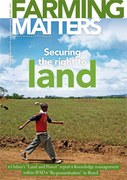Discourses and approaches to land rights have a long and complicated history, as do the various social and political contexts in which these discussions take place. There are numerous drivers of the renewed contests for control over land. Recently, the convergence of crises in the supply of food, feed, fibre, and in the financial and energy sectors, have heightened the competition for land resources between groups with very different levels of power and influence. Land contestation is likely to increase exponentially in the coming years and will renew the urgency to both (re)frame questions of land rights and to consider new forms of resistance to land rights violations. This edition explores a range of responses by different people and organisations to ensuring land rights in the face of increased competition for land, which can only exacerbate the unresolved problems of poverty and food insecurity.
The discourses that frame land rights discussions and seek to mobilise a new land tenure paradigm show a clear divergence in tactics.

On the other, those wishing for a moratorium, or radical land (re)distribution. Both are needed. Photo: Stephen Smith
Mainstream academics, international NGOs, (inter)national investors and the governments of developing countries often claim that, with proper regulation, responsible investments in land can have positive developmental outcomes. By contrast, others are looking beyond responses that will either endorse or marginally reform the current model of primitive accumulation. Instead, they seek a fundamental change in the dominant agrarian paradigms and a moratorium on land acquisition.
Mobilising for change need not be paralysed by this conceptual binary. Looking at the cases presented in this edition, it becomes apparent that there is a shared agenda for building broad-based alliances.
Because growing land pressure and competition for land affects marginal groups the most, it is essential to build and work in broad-based alliances. Inequality in power means that local land users who are most vulnerable to losing their land are most often those with the least means (either formal or informal) to (re)claim their land rights.
Moreover, the more contested land rights are, the higher the likelihood of (violent) conflict. As demonstrated in the Oxfam report, local elites and large investors often have the power to override the rights of legitimate land users. Local land tenure regimes are complex. There are overlapping international and national investment regulation protocols.
Another element is the increasingly transnational nature of capital, coupled with the under-regulated power of the (local) economic elite. Together these factors imply that addressing land rights necessarily involves speaking to power and politics. Tackling such power requires consolidated mobilisation and solidarity in a complex interplay of pragmatic (for example, the immediate formalisation of traditional land rights) and tactical (for example, Via Campesina’s location of land rights within a wider narrative of comprehensive agrarian reform) interventions. How might such broad alliances for land rights function in practice?
Giving it horns
Impondo zankhomo (or “the horns of the bull”) is the term for a Zulu battle strategy used during the reign of King Shaka. This analogy can be applied to describe movements for change that harness radically different approaches and groups. The metaphor of the bull’s horns describes the way in which disparate alliances can work in sync with each other and create a consolidated powerful body. The horns are very fast and can cover large (intellectual and ideological) distances. In this way, radicals can encircle and pin down their target.
Whilst the horns set the direction, the much larger main body has time to consolidate, align and, ultimately take a strong position, carrying the legitimacy and weight of a broad-based movement. We can see the right horn as representing those who wish to regulate land rights through codes of conduct, global principles, standards and guidelines, and the left horn as representing those wishing for a moratorium on the transfer of land rights or radical land (re)distribution in favour of the disposed and landless rural poor. Both are needed and cannot do without each other.
Manure of the revolution
2011 has been a year of people-driven resistance. The Arab Spring, the “Occupy” movement and the protests against austerity programmes in Europe all signal the ability of different people and their respective struggles to mobilise and unite. These movements are not owned by radicals and progressive thinkers; they are fundamentally owned by ordinary people allied with civic groups, NGOs, (new)media, organised social movements, academia, opposition politicians, and even the military. We see the “right-horn” reformists and the “left-horn” revolutionaries carrying forward a large coalition of ordinary people.
What can we learn from this in terms of mobilising for land rights? How can we sensitise, mobilise, and organise people, support small-scale producers and landless peasants and change the policies and the practice of governments, investors and financers in order to ensure more sustainable rural livelihoods and access to natural resources?
There is a common thread that links the patriarchal lynchpins of rural families with big (inter)national investors; progressive civil society with large development actors, and formal farmers’ unions with peasants’ movements. This thread is clearly visible throughout the articles in this edition of Farming Matters, which share a common narrative of power and inequality. We are unlikely to see a single global breakthrough in land rights governance or to witness a land rights revolution. But, these cases do demonstrate steady progress towards a shared view on ensuring and assuring land rights.
Maille Faughnan demonstrates that we can change how people think about gender equality; events in Araponga demonstrate that considerable change is possible when family farmers mobilise and expand their networks of social relations. The land rights movement in Nepal has been able to mobilise development partners, and Thea Hilhorst describes how land rights can be formalised in ways that do not disrupt social systems or dispossess existing holders of land rights. Reading through these narratives, I feel that Gine Zwart’s “smart lane” can be the new fast lane.
Text: Monique van Zijl
Monique van Zijl works as Policy Advisor for Oxfam Novib in the Netherlands.
E-mail: monique.van.zijl@oxfamnovib.nl


